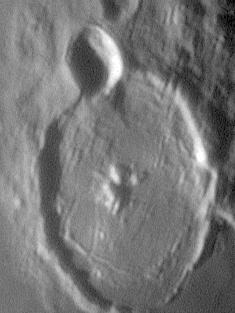Observing the Moon: Gassendi
Jack Kramer
Beginning when the Moon is about eleven days old, you can find the crater Gassendi by first locating the two prominent craters Plato and Copernicus near Mare Imbrium. Then draw a line from Plato to Copernicus, continuing for about another three-quarters of the distance between them, and you will be right around Gassendi. It lies on the edge of Mare Humorum, one of the oldest of the circular maria, believed to have been formed as the result of a massive impact by a small planetoid which struck almost perpendicular to the surface. Though Gassendi is almost perfectly circular, it appears oval because of foreshortening caused by it's proximity to the limb of the Moon.

Gassendi is a highly detailed crater with numerous intersecting rilles on its floor. Some of these are visible in the CCD image below, which is oriented with lunar north up. Observing a twelve day old Moon with my 3" refractor, I was unable to detect the rilles. However, a few months later I caught it right at the terminator of an eight-day-old Moon and in my 4" refractor the rilles stood out sharp and clear.
A jumble of three prominent peaks lies at the center. At the north end, the wall of Gassendi has been broken by another crater, Gassendi A. If this smaller crater looks especially deep, that's because it really is deeper than its host. Gassendi is about 6600 feet deep, while(Gassendi A is 8500 feet in depth. Also on the north side, two parallel "score marks" cut through the wall of Gassendi. Could they have been caused by flying debris?
Published in the June 1996 issue of the NightTimes




